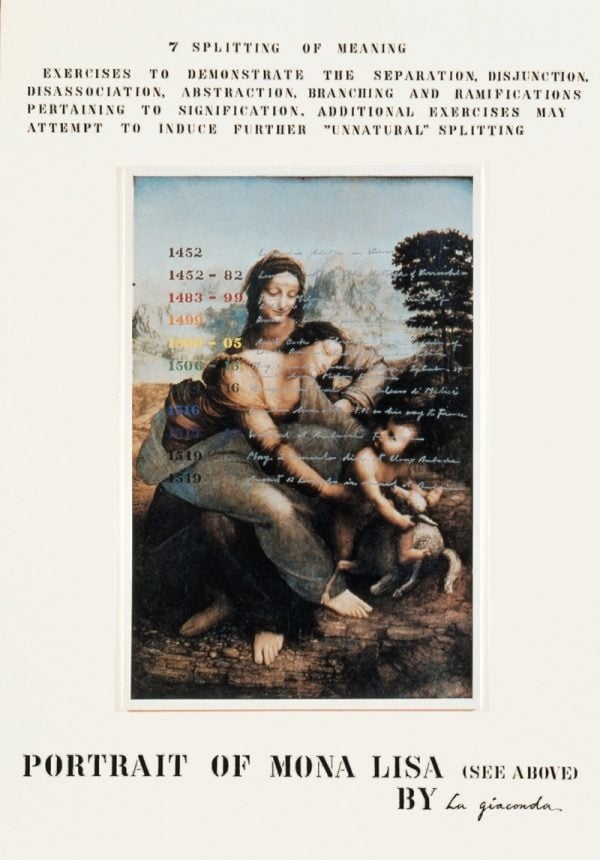Law & Politics
What Do Gagosian, Bernie Madoff, and a Multimillion-Dollar Conceptual Artwork Have in Common? One Heck of a Lawsuit.
Who is the rightful owner of The Mechanism of Meaning by the late artists Shusaku Arakawa and Madeline Gins?

Who is the rightful owner of The Mechanism of Meaning by the late artists Shusaku Arakawa and Madeline Gins?

Eileen Kinsella

A sprawling conceptual artwork titled The Mechanism of Meaning by the late artists Shusaku Arakawa and Madeline Gins is at the heart of a federal lawsuit filed yesterday by the nonprofit Architectural Body Research Foundation (ABRF).
The husband-and-wife duo Arakawa and Gins spent 10 years creating the 80-panel work, which is filled with complex puzzles, diagrams, and references to subjects ranging from physics to Chinese poetry. Duchamp—a close friend of Arakawa—was a frequent guest to their studio while the work took shape, and it was shown at the Venice Biennale in 1970 and the Guggenheim in 2007.
Now, it is the subject of an ownership dispute. The case revolves around two foundations set up at different times, each seeking control and proceeds from the possible sale of the work. Further complicating matters is the fact that one of the entities fell prey to the massive Bernard Madoff Ponzi scheme and was defrauded out of roughly $20 million and left virtually bankrupt.
The defendants named in the suit are the Reversible Destiny Foundation Inc (RDF)—a second foundation set up by the artists after the Madoff scandal—as well as the estate of the poet and artist Madeline Gins, the Los Angeles County Museum of Art director Michael Govan, and attorney and art law specialist Ronald Spencer, both of whom are directors of the RDF. Stephen Gins, Gins’s son and an executor of her estate, is also named as a defendant.
According to court papers, the artists established the first foundation, ABRF, in 1987 to fund the creation of large monuments and architectural sculpture. These projects have been described as “a logical extension” of their first major joint work, The Mechanism of Meaning. According to the complaint, the artists gifted The Mechanism of Meaning and all related background materials to the foundation.
But in late 2008, when they learned about the Madoff Ponzi scheme and their roughly $20 million loss, Arakawa and Gins “dramatically scaled back [the foundation’s] work, but continued research, writing, and planning activities.”
In March 2010, the artists created another organization, the Reversible Destiny Foundation, which sought to use architecture as “a tool to extend life and reverse death.” (The pair believed that by inhabiting off-kilter spaces with sloped floors and shrunken doors, residents would remain sharp both physically and mentally.)
They also established the new foundation to avoid having to surrender money from the original foundation that Madoff had falsely led them to believe they had in their account. But they “never transferred any property to RDF, much less its core holding, The Mechanism of Meaning,” according to the complaint.
Arakawa died shortly after the second foundation was formed, in May 2010, and Gins died in January 2014. The complaint alleges that the directors of RDF (the second foundation) and the executors of the Gins estate “have sought to loot” the original foundation by taking possession of its crown jewel.
The issue came to a head earlier this year when Gagosian Gallery signed on to represent Arakawa’s art on behalf of RDF. The complaint alleges that the gallery plans to sell one of the two editions of Mechanism of Meaning. The other edition was sold to the Sezon Museum of Modern Art in Japan in 1989 for about $3 million, though both editions are “now worth considerably more,” court documents state.
Garry Sesser, an attorney all of the defendants listed in the complaint, maintains that the dispute is a case of mistaken identity. The original foundation sold its edition to the Sezon Museum and RDF is the rightful owner of the last edition in private hands, he tells artnet News. “ABRF sold the works that are the subject of the 1987 deed of gift for $3 million to a Japanese museum in 1989. It’s pretty straightforward. The case has no merit and ABRF has been so advised.”
ABRF is seeking up to $1 million in punitive damages as well as attorney’s fees and a ruling that it is the rightful owner of the work. David Baum, the attorney for ABRF, told artnet News: “This is an important work of art and we look forward to it being returned.”